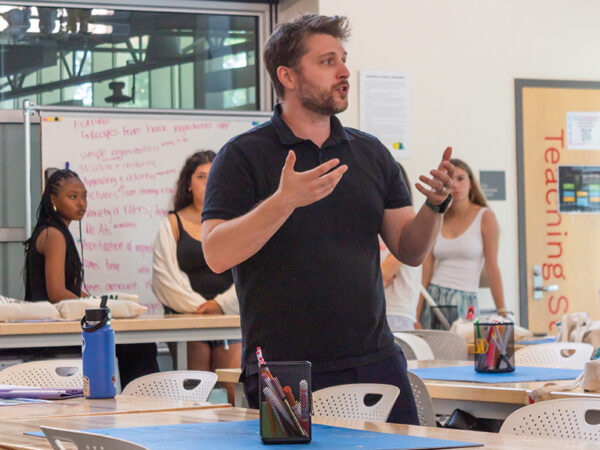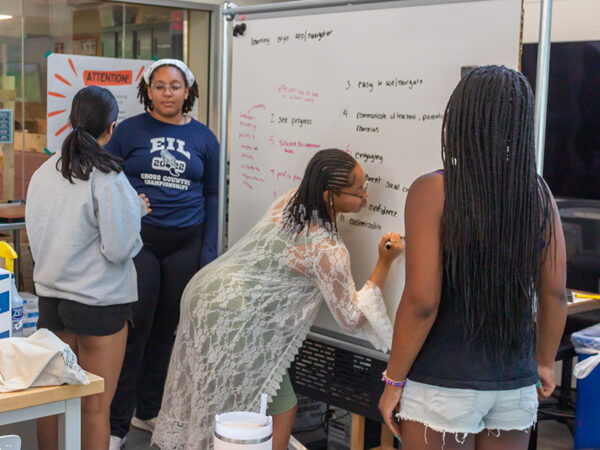Bringing Ideas to Life at Babson’s Weissman Foundry

A former middle and high school educator, Jonathan Griffiths appreciates the opportunity to work again with young minds.
“They’re really inquisitive. They have interesting ideas and interesting solutions,” he said. “They’re passionate and just love what they’re doing.”
Griffiths, the director of the Weissman Foundry at Babson College, enjoyed the chance to lead a group of high school students from the Dana Hall School in a prototyping and storytelling session last month, in conjunction with The Arthur M. Blank School for Entrepreneurial Leadership.
“It opens their eyes to how simple prototypes can be and how powerful those are,” Griffiths said. “I think it can be a transformative experience.”
The 19 rising juniors and seniors from the all-girls school in Wellesley, Massachusetts, spent the transformative and inspiring day on Babson’s campus as part of their weeklong Girls Summer Entrepreneurship Program (GSEP). This was the second year that Dana Hall students visited Babson as part of the GSEP, where students learn about the entrepreneurial process and work in teams to develop ideas for products.
WATCH: 2-Min Takeaways from the Dana Hall School visit, featuring Weissman Foundry Director Jonathan Griffiths.
At Babson, the students experienced firsthand the same Entrepreneurial Thought & Action® (ET&A™) approach that Babson’s students learn and employ. The experience at the Foundry is critical because it’s where their ideas begin to take shape and form.
“I’m really passionate about the thinking and the work that’s done in makerspaces and the type of applications that you can have in classrooms,” Griffiths said. “It’s actually so important, particularly in entrepreneurship education that this is something that every student at Babson does.”
Developing an Idea
The high school students arrived at Babson already having identified a problem and an idea to solve it. The five teams of students pitched app-based solutions to problems, such as: What to eat? What to wear? How to simplify technology for seniors? How to help identify students’ learning styles?

“They want to try to solve real-world problems,” Griffiths said. “They still want to try to solve kind of grandiose things that could radically transform lives.”
In the morning, Griffiths—along with program assistant Maddie Stoltz ’27‚ an Arthur M. Blank School for Entrepreneurial Leadership Scholar—led the students in a series of exercises to better develop their ideas. In breakout groups, the students worked together at whiteboards to identify and improve the top three features of their apps. Griffiths also encouraged the groups to focus on their target customers, visualizing and creating individual consumer profiles and giving them names such as Ralph and Bertha.
“It’s invaluable, because this is totally different than what you get in school day to day,” said Katherine Bradley, Dana Hall’s Head of School. “It totally builds on the things that you’re learning in school, but it’s not replicating them at all.”
Bradley also praised the Foundry as a space for hands-on learning, as well as the high engagement with the students.
“As is often the case in education, it’s the people that are making the difference,” she said. “Just listening to how (Griffiths) is interacting with the kids is amazing. Having somebody who really knows what they’re talking about but also knows how to connect with students is crucial.”
The Power of Prototyping
By the afternoon, the students will take their ideas and the information they’ve conceptualized into creating prototypes made of cardboard and basic materials, turning their ideas, even digital ones, into physical representations.
Griffiths says people often think prototyping involves 3D printing, AI, and other advanced technologies. “But construction paper, cardstock, and cardboard are frankly better and easier mediums to work within,” he said, “and can still truly articulate their ideas.”
“It’s really empowering to see students get that feedback on their idea in a 30-minute session of prototyping,” Griffiths added. “I do really think it’s going to transform what they’re thinking about what a prototype really is.”
“It’s fantastic to see students who take this nugget they learn right now in a one-day session, and then apply that over the next five or 10 or 15 years.”
Jonathan Griffiths, director, Weissman Foundry
Prototypes, even rudimentary ones, are important to help entrepreneurs share their vision and tell their story not only with customers but especially potential investors. For the Dana Hall students, they will be able to use what they’ve learned and their prototypes when the GSEP culminates with a “Shark Tank”-style pitch competition, called Dragon’s Lair, a nod to the school’s mascot.
“This kind of education is not something we currently have within our academic offering,” said Michelle Kiehl, program director of the GSEP, “so it’s very supplemental to what we do teach at Dana Hall, and it’s very special for our population to give them access to this education.”
Griffiths says introducing younger students to a space such as the Foundry, where they can easily create anything, can have a long-lasting impact.
“Most high schools don’t get this experience,” he said. “It’s fantastic to see students who take this nugget they learn right now in a one-day session, and then apply that over the next five or 10 or 15 years.”
‘Endless Possibilities’
In addition to lessons in prototyping and product development, one of the highlights for the students was to learn from Donna Levin, the inaugural CEO of The Blank School.

She shared her inspiring journey, beginning with growing up in Chicago, wanting to be a journalist because she idolized the title character of “The Mary Tyler Moore Show.” She shared the twists and turns of an impressive career that took her from college to a burgeoning tech career at companies such as Furniture.com and Upromise to co-founding Care.com, before transitioning to higher education and the opportunity to influence so many more future leaders.
“All of those opportunities, sometimes challenges, that you have in your life serve as a springboard for endless possibilities,” she said afterward, noting that despite the best plans and intentions, it’s often necessary and even beneficial to follow another path.
Levin was excited to share her experiences and lessons with an engaged group of female students. “It’s the conversation that I wish I had had. There weren’t a lot of opportunities to engage with female leaders or a peer group,” she said. “So, anytime I have an opportunity to engage with high school students, my answer is always yes.”
Levin was impressed by the young students from Dana Hall and the opportunities such as the prototyping experience at Babson provided. “It’s hugely valuable to realize that you can bring your ideas to life,” she said.
During the day, the students also enjoyed a campus tour and a Q&A with a member of the Admissions leadership team. “I wish every single one decides that Babson is their future,” Levin said, “or at least Babson is someplace on their continuous learning journey and agenda.”
Posted in Community, Entrepreneurial Leadership





